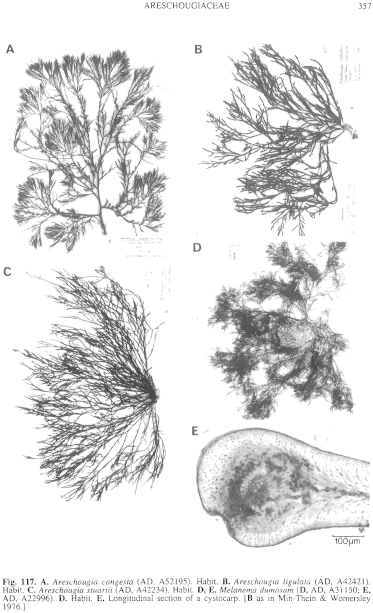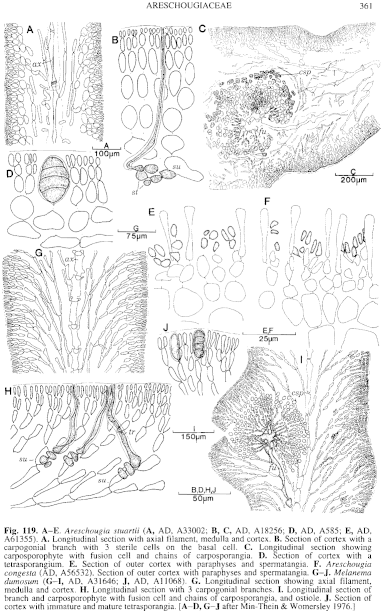|
|
|
|
|
|||||||||||
|
Electronic Flora of South Australia Species Fact Sheet
Phylum Rhodophyta – Class Florideophyceae – Order Gigartinales – Family Areschougiaceae
Selected citations: J. Agardh 1872: 26; 1876: 282. Kylin 1932: 37. Min-Thein & Womersley 1976: 65, figs 23, 24, 58B.
Synonym
Areschougia intermedia J. Agardh 1894: 129. Kylin 1932: 37, p1. 14, fig. 36.
Thallus (Fig. 117C) dark brown-red, cartilaginous, 10–20 cm high, much branched largely complanately, with compressed linear branches 1–2 mm broad, decreasing in length to lesser branches 2–5 mm long, basally constricted and with pointed apices; midrib visible on most branches. Holdfast discoid, 2–20 mm across, with several to numerous axes; epilithic. Structure (Fig. 119A) uniaxial, with each axial cell cutting off a single periaxial cell on three radii, becoming subopposite on successive cells, forming a lax medulla of periaxial filaments, soon filled with rhizoids, and a pseudoparenchymatous cortex 4–8 cells thick, inner cells ovoid and (15–) 20–45 µm in diameter, outer cells 4–6 (–8) µm in diameter and L/D 1–2; axial filament conspicuous throughout with cortical thickening on lower axes. Rhodoplasts discoid, becoming ribbon shaped, several per cell.
Reproduction: Sexual thalli dioecious; non-procarpic. Carpogonial branches (Fig. 119B) 3 (–4)-celled, borne on outer medullary cells, directed sideways with reflexed trichogynes, often with sterile cells on the lower cell(s). Connecting filaments 3–4, non-septate, occasionally branched; auxiliary cells formed by outer medullary or inner cortical cells, with adjacent cells becoming darkly staining and cutting off nutritive filaments. Gonimoblast initials produced first laterally, later radially from the stalked fusion cell, producing short chains of ovoid carposporangia (Fig. 119C) 15–25 µm in diameter. Cystocarps single or in small groups in lesser branches, slightly swollen, with slight filamentous enveloping tissue, ostiolate. Spermatangia (Fig. 119E) in nemathecia, between clavate paraphyses 18–22 µm long and 4–6 µm upper diameter, with the outer cortical cells cutting off 2–4 initials each producing 2–3 ovoid spermatangia 2–3 µm in diameter.
Tetrasporangia (Fig. 119D) scattered in the cortex of young branches, developed from mid cortical cells, pit-connected basally, ovoid, 30–50 µm long and 20–30 µm in diameter, zonately divided.
Type from Southport, Tas. (Stuart); lectotype in Herb. Harvey, TCD; isolectotype in AD, A18256.
Selected specimens: 12 km S of Vivonne Bay, Kangaroo I., S. Aust., 50–70 m deep (Latz, 24.xi.1968; AD, A33002). Encounter Bay, S. Aust., drift (AD, A585). 13 km off Cape Northumberland, S. Aust., 61 m deep (Shepherd, 7.v.1975; AD, A46291). Cape Lannes, S. Aust., drift (Womersley, 14.v.1972; AD, A42234). Port Phillip Heads, Vic. (Wilson, 7.i.1890; MEL, 44643). Marrawah, Tas. (Perrin 1362, March 1950; BM). Ninepin Point, D'Entrecasteaux Ch., Tas., 15 m deep (AIMS-NCI, Q66C 5062-S, 13.ii.1991; AD, A61355).
Distribution: Vivonne Bay, Kangaroo I., S. Aust., to Port Phillip Heads, Vic., and around Tasmania. Twofold Bay, N.S.W. (Millar & Kraft 1993, p: 25).
Taxonomic notes: Areschougia stuartii is slenderer than A. ligulata, has several axes from the holdfast, and is of eastern distribution compared with the latter which is a western species.
References:
AGARDH, J.G. (1872). Bidrag till Florideernes Systematik. Acta Univ. hind. 8, 1–60.
AGARDH, J.G. (1876). Species Genera et Ordines Algarum. Vol. 3, Part 1 - Epicrisis systematis Floridearum, pp. i-vii, 1–724. (Weigel: Leipzig.)
AGARDH, J.G. (1894). Analecta Algologica. Cont. II. Acta Univ. lund. 30, 1–98, Plate 1.
HARVEY, W.H. (1860a). Algae. In Hooker, J.D., The Botany of the Antarctic Voyage. 111. Flora Tasmaniae. Vol. II, pp. 321–343, Plates 185–196.
HARVEY, W.H. (1863). Phycologia Australica. Vol. 5, Plates 241–300, synop., pp. i-lxxiii. (Reeve: London.)
KYLIN, H. (1932). Die Florideenordnung Gigartinales. Lunds Univ. Årsskr. N.F. Avd. 2, 28 (8), 1–88, Plates 1–28.
MILLAR, A.J.K. & KRAFT, G.T. (1993). Catalogue of Marine and Freshwater Red Algae (Rhodophyta) of New South Wales, including Lord Howe Island, South-western Pacific. Aust. Syst. Bot. 6, 1–90.
MIN-THEIN, U. & WOMERSLEY, H.B.S. (1976). Studies on southern Australian taxa of Solieriaceae, Rhabdoniaceae and Rhodophyllidaceae (Rhodophyta). Aust. J. Bot. 24, 1–166.
The Marine Benthic Flora of Southern Australia Part IIIA complete list of references.
Publication:
Womersley, H.B.S. (14 January, 1994)
The Marine Benthic Flora of Southern Australia
Rhodophyta. Part IIIA, Bangiophyceae and Florideophyceae (to Gigartinales)
Reproduced with permission from The Marine Benthic Flora of Southern Australia Part IIIA 1994, by H.B.S. Womersley. Australian Biological Resources Study, Canberra. Copyright Commonwealth of Australia.
Illustrations in Womersley Part IIIA, 1994: FIGS 117C, 119 A–E.

Figure 117 enlarge
Fig. 117. A. Areschougia congesta (AD, A52195). Habit. B. Areschougia ligulata (AD, A42421). Habit. C. Areschougia stuartii (AD, A42234). Habit. D, E. Melanema dumosum (D, AD, A31150; E, AD, A22996). D. Habit. E. Longitudinal section of a cystocarp. [B as in Min-Theis & Womersley 1976.]

Figure 119 enlarge
Fig. 119. A–E. Areschougia stuartii (A, AD, A33002; B, C, AD, A18256; D, AD, A585; E, AD, A61355). A. Longitudinal section with axial filament, medulla and cortex. B. Section of cortex with a carpogonial branch with 3 sterile cells on the basal cell. C. Longitudinal section showing carposporophyte with fusion cell and chains of carposporangia. D. Section of cortex with a tetrasporangium. E. Section of outer cortex with paraphyses and spermatangia. F. Areschougia congesta (AD, A56532). Section of outer cortex with paraphyses and spermatangia. G–J. Melanema dumosum (G–I, AD, A31646; J, AD, A11068). G. Longitudinal section showing axial filament, medulla and cortex. H. Longitudinal section with 3 carpogonial branches. I. Longitudinal section of branch and carposporophyte with fusion cell and chains of carposporangia, and ostiole. J. Section of cortex with immature and mature tetrasporangia. [A–D, G–J after Min-Thein & Womersley 1976.]

|
Email Contact: State Herbarium of South Australia |

|